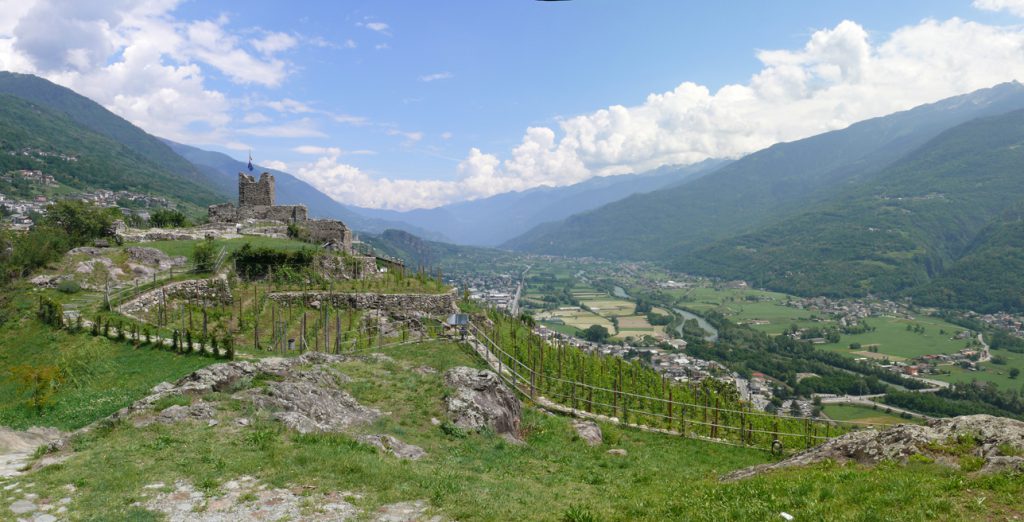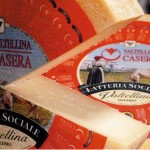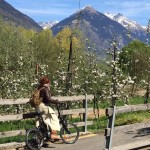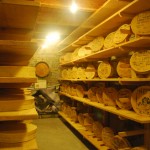Visit the huge apple fields and get your bite
Valtellina’s wine: Nebbiolo
The vine grows everywhere, but only here the Nebbiolo is perfect
by Syusy Blady
I am at the castle of Grumello, in Valtellina, protected by FAI (Italian Environment Facility). A geologist, Siro, is telling me that the centre of the ruins of this castle represents the ideal position to look at the whole valley and understand its geological characteristics. At the bottom there is the hump of the Sassella and there is a depression on the right that shows us the insubric line, or the junction line between the Paleoafrican tectonic plate and the European one. The castle is located right on the junction of this fracture. It is from its pushing that the Alps and the Pre-Alps raised. We’re in it right now, in perfect balance! And this perfect balance produces the typical wine of Valtellina: the Nebbiolo, which originates from this lucky slope, bathed by the sun all day long. On the other slope the sun is much less warming.

Castel Grumello by Flickr user mauroghilardini
The other side of the sun warms much less, in fact there is not much less life and above all there is the wine! The Nebbiolo originates on the sunnier side and the tradition dictates that it is grown on these terraces created over the centuries by the patient work of the peasants. All the vineyards here in Valtellina are hand-built terraces that extend for 2500 km, a real Chinese wall in Lombardy! Formerly the vines used to grow up to 900m, now it reaches 600m at most.
The Nebbiolo chooses its territory, the vines grow everywhere, but they express their peculiarity only where the territory allows it, and Valtellina is the perfect place. So in the end it is true that it’s the Nebbiolo who choses its territory! Men provide it with terraces where it can grow, and this heritage, the landscape of Valtellina, which took hundreds of years to be formed. However, this territory would shutter if it wasn’t maintained by the work of the winegrowers who climb up here to take care of the walls and the vines. Despite the rocks, the vines manage to grow, like does the olive tree in some parts of Italy.
Actually, it doesn’t take a lot of effort, it doesn’t need a very fertile soil, but the Nebbiolo does need a lot of light and the terraces south-facing have a gradient of 30° and look like natural solar panels! The vines bathe in the sun all day long, but even too much warmness is nocive. Fortunately the Lake Como and the Alps create an optimal temperature gradient. A pleasant breeze seep through the valley, a steady wind that ventilates the vineyards during the day. Indeed, I fell like the Nebbiolo: I enjoy staying in the sun, but without it being hard to breathe. In the end, I love the ideal weather of Valtellina!
Syusy Blady
⇒ Watch the full web serie Valtellina Slow Tour
Video full text: Valtellina’s wine
We’re in the Valtellina, at Grumello Castle,
preserved and protected by the National Trust for Italy, the FAI, and by Gianni.
I’m with Siro in the centre of the castle’s ruins.
This is the perfect position from where to see the entire Valtellina valley,
and to understand its geological makeup.
We’re up at Grumello castle and that is the Sassella ridge.
Can you see that depression that drops down from the right? It shows us where the Insubric line is,
and it’s the point where the paleo-African and European plates meet.
We are right on that join.
This fracture crosses the Alps in their entirely and it’s the reason why these mountains are here.
It pushes and the Alps and the Alpine foothills lift upwards.
And you’re right in the middle of it, in perfect harmony!
This is the perfect harmony that produces the wine that is native to the Valtellina, Nebbiolo.
Nebbiolo originates from this marvellous sunlit slope.
This side of the valley is fortunate enough to be bathed by the sun all day long.
The other side gets a lot less and in fact there’s less life there.
And above all there isn’t the wine!
Nebbiolo only grows on this side.
Tradition demands that it is grown on these terraces,
created patiently over the centuries by the farmers.
All of the vineyards in Valtellina are on terraces that were created by hand.
They extend for 2500km.
Everybody once had their own piece of land, some good and some not so good.
The vine once rose to heights of up to 900 metres, but now it’s a maximum of 600.
But that’s only right, this is the pinnacle!
It’s the Nebbiolo that chooses the area.
The vine grows everywhere,
but the Nebbiolo expresses its peculiar features only where an area allows it to.
The Valtellina is the perfect place for growing the Nebbiolo grape.
It chose to be here!
This heritage has taken hundreds of years to develop.
But it crumbles away if it isn’t maintained through the hard work of the vine-dressers
who climb up as far as here to tend to the walls and the vines.
Despite the rocks the vines continue to grow, just like the olive trees do in some parts of Italy.
It’s doesn’t take much, not even really fertile soil.
What it needs is a lot of light.
The terraces are southward looking and have an average inclination of 30 degrees.
They’re just like solar panels.
The vines take in the sun from morning ’till night.
But too much heat doesn’t do them good either.
We need the heat, but not too much.
Thankfully Lake Como and the Alps create this different thermal gradient.
This breeze, the lake’s Breva, penetrates along the valley.
It’s a constant wind that ventilates our vines during the day.
But did you know that I’m like the Nebbiolo?
I love to linger in the sun… I too have become fond of the Nebbiolo!
This is the birthplace of famous wines such as Inferno, Grumello, Sassella and Sforzato,
as well as Valgella and Maroggia.
The vineyards of the Valtellina are considered a masterpiece of Alpine farming,
that involves an area of approximately 1250 hectares extending from Morbegno to Tirano.
Farming the land in an area such as this requires special skills.
The history of the Valtellina has seen 1000 years of such farming.
Passing the vine down from one generation to the next is this area’s greatest value.
When a product is so special, the trip is worth it,
and travelling towards a product is important.
And to be a tourist in this valley it’s worth getting around by bicycle!














